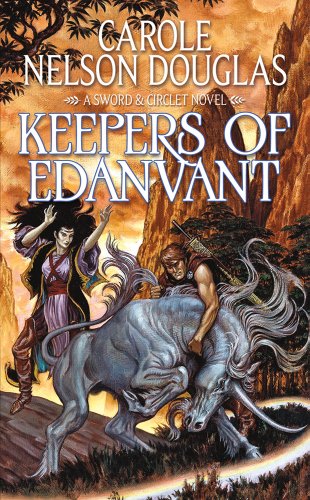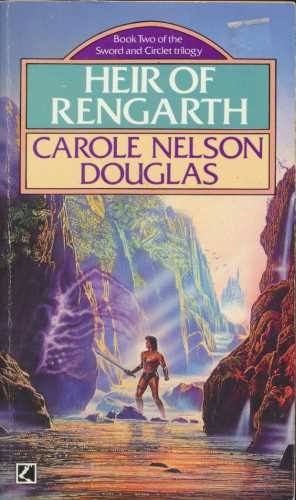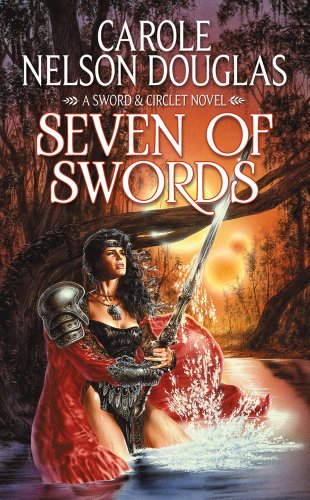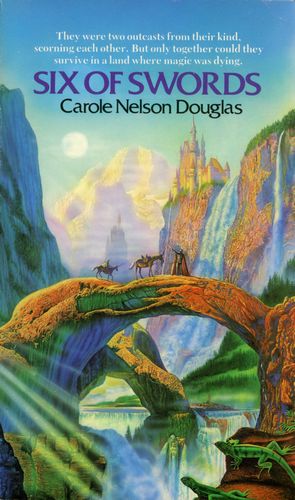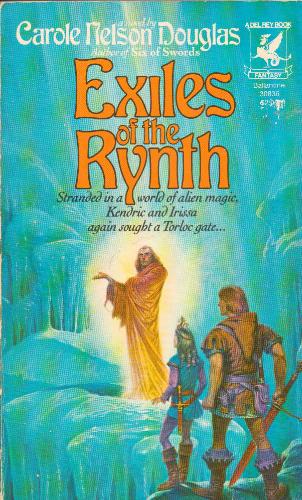Battle of the Sexes: Sword & Circlet Volume 1 by Carole Nelson Douglas
Earlier this year I wrote about two books by Carole Nelson Douglas which became known as the Kendric and Irissa duology. These eighties’ fantasy classics spawned a subsequent trilogy, The Sword and Circlet. Whilst I had this trilogy on hand, I thought a break was in order after completing my review of Six of Swords and Exiles of the Rynth. John had been enticing me to visit some other neglected volumes on my shelf through his ongoing Vintage Treasures posts which saw me breeze through some Wyndham and Vance (which I posted mini-reviews for, in the comments of each article). With this post, I am back to focus on Carole Nelson Douglas.
When one starts to read volume one of the Sword and Circlet Trilogy it becomes immediately clear that this is no afterthought, or clumsy tack on to ride the wave of success the first two books experienced. Keepers of the Edanvant picks up almost immediately where Exiles of the Rynth left off, pausing only to provide a small prologue and recap of what had gone before.
The complete Sword & Circlet series consists of five books.
1 Six of Swords (1982)
2 Exiles of the Rynth (1984)
3 Keepers of Edanvant (1987)
4 Heir of Rengarth (1988)
5 Seven of Swords (1989)
Keepers of the Edanvant starts immediately after the duology
By the end of Exiles of the Rynth, Kendric and Irissa had resolved many of their issues and, in so doing, were able to overcome the great evil that had plagued The Inlands of Ten. Shortly thereafter, the ancient Torloc seeress Finorian, once Irissa’s tutor, appeared to the duo, enjoining them to make their way through a new gate. The very future of the Torloc race was at stake.
The mystical, and apparently immortal, creature known as The Rynx, who, finding its ancient foe deceased and itself thus at a bit of a loose end, decided to join them through the gate. What soon became apparent is the green world that Kendric, Irissa and The Rynx find themselves on is Edanvant (the Torloc homeworld). Edanvant is briefly mentioned in Six of Swords, along with another land called Rengarth, in such a way as one may speak of Lemuria or Atlantis. Some mystical land that once may have existed.
They journey through a lush forest in an idyllic setting, but all is not as it seems. There is no twitter of birdsong among the trees. Flowers, while beautiful, have no scent. One gets the impression the forest is a facsimile of what a real forest should be. The story proceeds at a rapid pace with the heroes doing a little exploring and having some small adventures before they find their way to a keep. Here Finorian, and a handful of Torloc women who had journeyed through the random gate which had opened at Rindell (at the start of Six of Swords), were in residence.
One soon learns that Finorian’s plea for Irissa to join her fellow Torlocs was no idle whim. Irissa had been brought up in a matriarchal society, having never laid eyes on a Torloc man, or indeed any man, until she met Kendric. The only Torloc man who still existed in The Realms was the Sixth Wrathman, who had been killed by the evil magician Geronfrey, and who Irissa had never met. The rest of the men had left The Realms before her birth, on various magical quests.
Kendric and Irissa duology
The Torloc men, or more precisely the few Torloc men who survived their quests, are also in residence on Edanvant. That in itself is the problem. Small tidbits of Torloc history and customs which the author dropped in the previous books start to form a pattern. One discovers that the men, having no innate magic of their own had gone on quests to find magical talismans. Finorian has vigorously opposed these quests, decrying talismanic magic as unnatural, the quests as spurious.
Much of this has to do with power plays
The women, led by seeress Finorian, want to maintain command over the men; conversely, the men, strive for self-determination and equal footing with the bearers of innate female magic. The eventual outcome of this, over many years, has been a rift between Torloc men and women.
The few men who survived their quests made their way to Edanvant and are ensconced in a gargantuan castle called Citydell. Feeling betrayed by the Torloc seeresses, they are embittered and, now having their own magic, emboldened, no longer wishing to play second fiddle to the Torloc women.
Irissa finds herself in the middle of this power struggle. She has matured, and in so doing, become quite powerful in her own right. No longer a child to be coerced by Finorian, she determines to find the men and see what is really going on. Kendric for his part, having overcome his loathing for the magic he inherited from Irissa in Six of Swords, has to come to terms with his own place in the story. The Rynx does not come to the fore as a third main protagonist, rather punctuating portions of the story, dangling enticing tidbits as to its real nature.
The setting is powerful. Once again it differs much from the classic fantasy tropes which have been copied so many times. As one has come to expect, Ms. Nelson Douglas packs the entire story into a small area, indeed Keepers of the Edanvant occurs in a far tighter confine than the previous two books. Other characters from the previous books make appearances with their history being expanded upon.
At the risk of being lambasted for the statements to come, I apologise in advance if they come across as clumsy. I am just saying it as I saw it:
Initially, when the author started to expand on the women-vs-men power struggle, I felt a bit of a shudder, recalling the overhanded way in which this can, and has been, handled before. Dark days of my teenage youth struggling through The Mists of Avalon were recalled. I was thus very pleasantly surprised at the even-handed way in which the author covered the topic. Both sides were portrayed fairly, each with their advantages and faults.
The themes of betrayal, hurt and manipulation came to the fore as the book progressed, with secondary characters, most notably Irissa’s mother and father, being used as a conduit to explain the issues at hand. The end result of the segregation of each sex has become a sort of cold war, with each side suspecting the other and wondering if, and when, they should initiate a pre-emanative strike.
Keepers of the Edanvant was published in 1987 as a paperback by Tor in the USA, and by Corgi in the UK. My Tor version (with the Steve Hickman cover) came in at 346 pages. The Corgi version was published a year later with a cover by Steve Crisp. The second printing from Tor occurred in 2012.
Tony Den posts occasional retro reviews to keep the light of eighties’ fantasy burning. His most recent contribution has been the coverage of Carole Nelson Douglas’ seminal Six of Swords and Exiles of the Rynth books.
